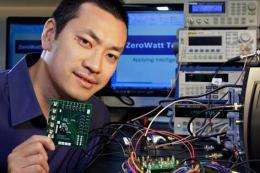Little chip, big implications

You might say they “zeroed” in on a groundbreaking idea.
It was November 2008, and doctoral student Fred Tzeng was brainstorming research projects with his adviser, Payam Heydari, UC Irvine professor of electrical engineering & computer science. After much discussion, they conceived of a concept – a way to more intelligently convert analog signals (sound, light, heat, motion) to the digital format required by modern electronics, using 10 times less power than the current conversion process.
If it worked, their low-power analog-to-digital converter technology would extend battery life, enhance functionality and lower the cost of portable electronics. Potential applications ranged from automobiles, airplanes, industrial machinery, medical devices and sensors to satellites, CD players, scanners and cellphones.
After a few failed attempts, Tzeng and Heydari configured a simulation that showed promise. With the help of UCI’s Office of Technology Alliances, they applied for the first of three patents, and the seed of their business was planted. ZeroWatt Technologies went on to win the 2009 Business Plan Competition at UCI’s Paul Merage School of Business.
The new company incorporated and sought grants from NASA, the U.S. Navy and the National Science Foundation. NSF gave the entrepreneurs a Small Business Innovation Research grant of $150,000, which allowed Tzeng to quit his two part-time jobs and work full time on ZeroWatt.
To take the fledgling company to the next level, he and Heydari needed a place to set up shop, so they turned to TechPortal, a business incubator at the UCI-based California Institute for Telecommunications & Information Technology for startups using technology licensed by the University of California.
“TechPortal offered a good price, good support and excellent networking opportunities,” including introductions to local business people, lawyers, investors and tech-company executives, says Tzeng, now ZeroWatt’s chief technology officer.
ZeroWatt is TechPortal’s third tenant. In February 2011, it moved into a 150-square-foot lab on Calit2’s second floor, joining BiMaple Inc. and Shrink Nanotechnologies Inc. A fourth startup, Tear Diagno, has since taken up residence as well.
For now, ZeroWatt is pursuing prospective partners in the semiconductor manufacturing business, primarily microcontroller suppliers. But its principals are also prepared to meet with venture capitalists who might be interested in investing. They’ve applied for the second phase of the NSF grant to fund development while they raise capital from other sources.
Heydari, ZeroWatt’s chief scientific adviser, is not new to the process of technology transfer. The Office of Technology Alliances has named him one of 10 outstanding innovators at UCI. With five patents secured and five more pending, Heydari has built a number of novel integrated circuit systems that have ended up in surveillance and medical applications.
But this is his first startup business. “TechPortal has been a great place for us to get established and give demonstrations to potential partners,” he says.
Today, three years after Tzeng and Heydari conceived the technology, ZeroWatt has two non-advisory employees. Tzeng – who earned bachelor’s, master’s and doctoral degrees in electrical engineering at UCI – was joined in 2011 by Vipul Mehta. A former Western Digital executive and co-founder of Aristos Logic, a chip company that was sold to a larger Silicon Valley concern, Mehta serves as ZeroWatt’s president and CEO.
He and Tzeng have been demonstrating their third-generation prototype, which utilizes the patent-pending intelligent analog compression engine, or ACE. They’ve shown the chip to six potential strategic partners.
“There is a big market for our technology, so the challenge is where to start. We want to go where we can make the biggest difference,” Tzeng explains.
Prospective market sectors include:
• Medical and healthcare (ultrasound and cardiac devices and hearing aids);
• Automotive (sensors, instrumentation, hybrid vehicles);
• Communications (broadband, local networks);
• Computers (audio, video, wireless);
• Consumer (mobile phones, audio and video players);
• Defense and military (sensors, satellites); and
Industrial (production machinery, measurement devices, sensors).
“We’re exploring business models and staying open to possibilities,” Tzeng says. “At the same time, we need to maintain momentum and eventually move out of startup mode.” Tzeng will talk about the business side of science from 5-5:30 p.m. Thursday, Feb. 2 in the McDonnell Douglas Engineering Auditorium. The talk is part of the Entrepreneurship Seminar Series sponsored by the Henry Samueli School of Engineering.
Mehta is optimistic: “This is a compelling, game-changing technology that provides real benefits to a broad range of applications. It constitutes a powerful building block that partner companies can integrate into their own products and offers breakthrough solutions spanning multiple markets. Everyone we’ve shared the technology with has been very impressed.”
Provided by University of California, Irvine





















